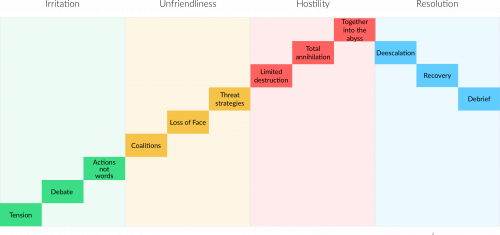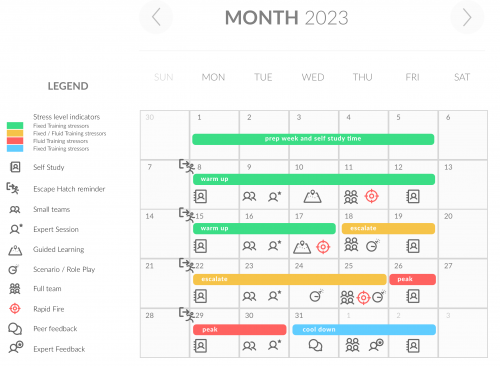Part 3: Greenpeace’s Critical Incident Network Advanced Comms Training
Designing educational programming requires zooming in and out of learner needs, organisational realities, and the impact you wish to have on the world. In this series, we’re writing about an educational project we’ve been working on with Greenpeace International for a number of years. If you haven’t read Part 1 and Part 2 of this series, you might want to do that first!
In this post, we will talk about the structures and curriculum underlying the Critical Incident Network (CIN) Advanced Comms training.
Structuring Stress
Taking a formerly in-person training and making it digital isn’t just typing things up into the computer and calling it done. A digital training environment should mimic the vibe of an in-person training as much as possible. For critical incidents and crisis management, this means mimicking stressful situations.
Introducing stress elements is crucial for preparing individuals for real-world crisis scenarios. Stressors like time constraints and emotional pressure help to simulate the unpredictability and urgency often encountered in critical incidents. This enables learners to build resilience and adaptability, skills that can’t be developed in a purely theoretical environment.
Part of the stressors that we can place upon learners include placing demands upon time, emotional resilience, and communication strategies. Training, however, needs to be a safe space for learning. This means learners need scaffolding, structure and support.

The training programme is designed to escalate in intensity into a crescendo at the end of Week 3. In addition, each scenario involves escalations which each team involved in the training will have to choose how to manage.
Scaffolding
Learning design requires finding ways to structure time and information so that participants can focus on developing the skills and attitudes required. In professional development, there is the added complication that many people take training courses in addition to their regular jobs. Figuring out a cadence to a training is important, as is documenting that cadence. This helps learners know what to expect and what is expected of them.

The CIN Advanced Comms training takes place over a period of four weeks and includes a range of approaches from self study, through to working in small teams, expert sessions and role play. We chose a blended learning, multi-modal structure to ensure that we could adequately address complex topics. A month gives us enough time to get through the curriculum, while being compact enough to keep engagement high.
Choosing appropriate digital tools and platforms enhance the learning experience, and this offers flexibility for learners to access materials and engage with the content at their own pace. Regular communication, both in-person and through digital channels, help provide support and foster a sense of community among learners. This blend of instructional methods and modalities not only enhances learner engagement but also equips learners with valuable digital and communicative skills.
Each week in the CIN Advanced Comms training, participants have one module of online learning to complete. This content introduces concepts, processes and best practices from within Greenpeace. It is self-paced, so the participant determines how much time they devote to this work. Synchronous sessions are then held at the same time each of three days during a week.
We continuously assess and adapt our curriculum, using feedback and data analytics to identify areas for improvement and tailor the learning experience to meet diverse needs.
Building Teams
Learning is an experience and we remember good experiences. In learning design, we strive to help learners create connections not only with the concepts or skills they’re there to learn, but also with each other.
The CIN Advanced Comms training is a collaborative experience. People learn to work together, collaborate in stressful situations, and to trust each other. The training forms 5–6 person teams with participants fulfilling various communications roles- such as Comms Lead, Digital Lead, Press Officer, Internal Comms, Editor or Media Producer. Other roles in the organisation (e.g. security personnel, HR managers, journalists, campaign directors, lawyers, etc) are enacted through a combination of asynchronous training materials, as well as the trainers and CIN community members.
Given the complexity of the training we’re designing, we work with a range of trainers with different backgrounds. Remember, we are building multiple pathways deepening the community’s engagement in this work. We’ve developed a Train the Trainer (TtT) programme as well and aim to help people level up within the community. Stay tuned for a future post on the TtT.
Each team has several trainers to help guide them. We call the constellation of trainers for the CIN Advanced Comms training the Training Committee.
Roles on the Trainer Committee:
- Lead trainers run their team of trainers as well as the training sessions for their dedicated group of participants.
- Co-Trainers are confident trainers that support their lead trainer in facilitating the scenario sessions.
- Scenario Support are experienced in scenario based training and can advise other trainers on how to conduct scenario based training best.
- Training Coordinators The coordinator(s) ensure that the training works across focus teams and inline with pace and content. They also keep a close loop to the lead trainers and provide support for the learning design and technical channels.
- Shadow Trainers are people who want more experience as a trainer before potentially stepping up. Their main objective is to learn and to support their fellow trainers.
The Curriculum

We talked about our five learning objectives in the last post, but as a reminder the Critical Incident Network Advanced Comms Training is focused on:
- Shared understanding — building a shared vocabulary and mental model for critical incidents so that people can apply the appropriate tactics and techniques for crisis communications
- Decision-making — identifying relevant information, making a judgement, and choosing a path forward
- Collaboration under pressure — supporting other individuals and the team to respond effectively in difficult and stressful situations
- Stress resilience — developing self-awareness to understand capacity and desire for dealing with difficult and stressful situations
- Conflict reframing — articulating risks to identify communication opportunities
We focus each week on content that stretches between and around those five objectives.
Prep Week: Setting the Scene
- Main objective: We begin with metacognition, or ‘thinking about thinking’. What’s the link between thinking and behaviour? What role does personality play in conflict? How can we develop a better mindset to deal with critical incidents?
- Focus of the week: Preparing for the coming weeks, and doing some self-study.
- What’s tricky: Finding and dedicating the time it takes to really commit to learning.
Week 1: Terms, Roles & Tactics
- Main objective: This week is about developing a shared understanding and sharpening decision making skills. What is the difference between a critical incident and a crisis? What is an issue? What does risk mean in our context? Who is responsible during a critical incident and what are best practices in communication in these situations?
- Focus of the week: Coming together as a team working to respond to a communication crisis.
- What’s tricky: People respond differently in crisis situations! How will personalities show up this week?
Week 2: Comms & Collaboration in a Crisis
- Main objective: We continue to develop decision making skills and shared understanding of crisis communication. In addition, we focus on dealing with the social, cultural and other dynamics of crisis incidents. How do we deal with internal and external communication? How do we collaborate in these times?
- Focus of the week: Making good decisions in communication, both internal and external and being observant of people around you.
- What’s tricky: Communication can be complex, with disinformation, trolls, negativity and political nonsense. Can you keep your cool and work collaboratively?

Week 3: Reframing Conflict
- Main objective: In week 3 the heat is turned way up, and participants use everything they’ve learned to respond to scenarios that will challenge them to think quickly, make sound decisions and take smart risks.
- Focus of the week: Responding as quickly as possible to critical incidents, as well as seeing opportunities and being prepared before an issue becomes a critical incident.
- What’s tricky: Thinking deeply about potential risks would be easy if we weren’t under time pressure or if we had a crystal ball. Can learners reframe situations, protect people involved and communicate well?
Week 4: Debrief & Cool down
- Main objective: The CIN Communication training is designed to stress people out a little bit. It deals with tough situations, so week 4 is all about debriefing and reflecting on the experience.
- Focus of the week: Reflecting and identifying the primary stressors people experienced during scenarios. We explore experiences and come up with some proactive strategies together with learners.
- What’s tricky: Developing self-awareness is a lifelong endeavour. To understand our own capacity and desire for dealing with difficult and stressful situations is part of what this training is all about!
There’s so much more
As we explained in our first post of this series, this programme is about building a community of practice. There’s a lot to that, and we’ve focused this series particularly on the learning elements of the Critical Incident Network programme.
As you’re designing learning experiences, pay attention to the scaffolding of information and learner engagement. You’ll want to build teams and relationships to strengthen peer to peer learning and reflection. You need to set learning objectives and be clear about how those objectives are achieved through the curriculum of the programme.
Which of the planning strategies and learning design advice from this series are you most excited about?
This body of work is built on the back of incredible contributions from a wide variety of people. In particular, we’d like to thank Greenpeace International’s Elizabeth Godwin, the Global Lead of Digital Learning, Patric Salize, the Global Communication Hub Coordinator and Mike Townsley, the Communications Director for their collaboration and direction.